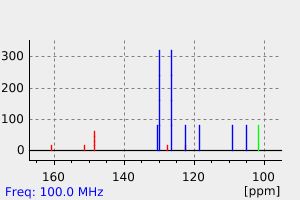texamine
中文名称
——
中文别名
——
英文名称
texamine
英文别名
5-(benzo[d][1,3]dioxol-5-yl)-2-phenyloxazole;5-(1,3-Benzodioxol-5-yl)-2-phenyl-1,3-oxazole
CAS
——
化学式
C16H11NO3
mdl
——
分子量
265.268
InChiKey
GEEMIKSHBWESFK-UHFFFAOYSA-N
BEILSTEIN
——
EINECS
——
-
物化性质
-
计算性质
-
ADMET
-
安全信息
-
SDS
-
制备方法与用途
-
上下游信息
-
文献信息
-
表征谱图
-
同类化合物
-
相关功能分类
-
相关结构分类
计算性质
-
辛醇/水分配系数(LogP):4.5
-
重原子数:20
-
可旋转键数:2
-
环数:4.0
-
sp3杂化的碳原子比例:0.06
-
拓扑面积:44.5
-
氢给体数:0
-
氢受体数:4
上下游信息
反应信息
-
作为产物:参考文献:名称:Sengupta, Saumitra; Mondal, Somnath, Indian Journal of Chemistry - Section B Organic and Medicinal Chemistry, 2002, vol. 41, # 4, p. 854 - 855摘要:DOI:
文献信息
-
C–H arylation and alkenylation of imidazoles by nickel catalysis: solvent-accelerated imidazole C–H activation
-
一种恶唑杂环化合物的合成方法
-
Radical C–H Arylation of Oxazoles with Aryl Iodides: dppf as an Electron-Transfer Mediator for Cs<sub>2</sub>CO<sub>3</sub>作者:Zhengwei Guo、Man Li、Xue-Qing Mou、Gang He、Xiao-Song Xue、Gong ChenDOI:10.1021/acs.orglett.8b00530日期:2018.3.16A radical C–H arylation reaction of oxazoles with (hetero)aryl iodides using Cs2CO3 as base/electron donor and 1,1′-bis(diphenylphosphino) ferrocene (dppf) as a catalytic SET mediator is reported. The overall reaction likely follows the general base-promoted homolytic aromatic substitution mechanism through a radical-chain pathway. DFT calculations suggest that dppf forms a complex with CsCO3–, enhancing
-
Photoinduced Copper-Catalyzed C−H Arylation at Room Temperature作者:Fanzhi Yang、Julian Koeller、Lutz AckermannDOI:10.1002/anie.201512027日期:2016.4.4Room‐temperature azole C−H arylations were accomplished with inexpensive copper(I) compounds by means of photoinduced catalysis. The expedient copper catalysis set the stage for site‐selective C−H arylations of non‐aromatic oxazolines under mild reaction conditions, and provides step‐economical access to the alkaloid natural products balsoxin and texamine.
-
Synthesis of 2,5-disubstituted oxazoles <i>via</i> cobalt(<scp>iii</scp>)-catalyzed cross-coupling of <i>N</i>-pivaloyloxyamides and alkynes作者:Xiaolong Yu、Kehao Chen、Qi Wang、Wenjing Zhang、Jin ZhuDOI:10.1039/c7cc08611c日期:——An efficient synthesis of 2,5-disubstituted oxazoles via Co(III) catalysis is described herein. The synthesis is achieved under mild conditions through [3+2] cycloaddition of N-pivaloyloxyamides and alkynes. The reaction operates through an internal oxidation pathway and features a very broad substrate scope. The one-step synthesis of natural products such as texamine and balsoxin has been demonstrated
表征谱图
-
氢谱1HNMR
-
质谱MS
-
碳谱13CNMR
-
红外IR
-
拉曼Raman
-
峰位数据
-
峰位匹配
-
表征信息
同类化合物
(SP-4-1)-二氯双(1-苯基-1H-咪唑-κN3)-钯
(5aS,6R,9S,9aR)-5a,6,7,8,9,9a-六氢-6,11,11-三甲基-2-(2,3,4,5,6-五氟苯基)-6,9-甲基-4H-[1,2,4]三唑[3,4-c][1,4]苯并恶嗪四氟硼酸酯
(5-氨基-1,3,4-噻二唑-2-基)甲醇
齐墩果-2,12-二烯[2,3-d]异恶唑-28-酸
黄曲霉毒素H1
高效液相卡套柱
非昔硝唑
非布索坦杂质Z19
非布索坦杂质T
非布索坦杂质K
非布索坦杂质E
非布索坦杂质D
非布索坦杂质67
非布索坦杂质65
非布索坦杂质64
非布索坦杂质61
非布索坦代谢物67M-4
非布索坦代谢物67M-2
非布索坦代谢物 67M-1
非布索坦-D9
非布索坦
非唑拉明
雷非那酮-d7
雷西那德杂质2
雷西纳德杂质L
雷西纳德杂质H
雷西纳德杂质B
雷西纳德
雷西奈德杂质
阿西司特
阿莫奈韦
阿考替胺杂质9
阿米苯唑
阿米特罗13C2,15N2
阿瑞匹坦杂质
阿格列扎
阿扎司特
阿尔吡登
阿塔鲁伦中间体
阿培利司N-1
阿哌沙班杂质26
阿哌沙班杂质15
阿可替尼
阿作莫兰
阿佐塞米
镁(2+)(Z)-4'-羟基-3'-甲氧基肉桂酸酯
锌1,2-二甲基咪唑二氯化物
锌(II)(苯甲醇)(四苯基卟啉)
锌(II)(正丁醇)(四苯基卟啉)
锌(II)(异丁醇)(四苯基卟啉)







